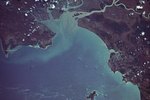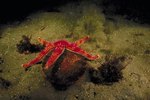
Coral reefs account for less than 1 percent of the planet's marine ecosystems, yet they support a quarter of all ocean life, including vertebrates -- animals with backbones -- and invertebrates. Major reef systems include Australia's Great Barrier Reef, the world's largest; the Mesoamerican Reef, which spans the length of Central America; and the Coral Triangle in the western Pacific Ocean, which surrounds such island nations as Papua New Guinea and the Philippines.
Corals Are Invertebrates
Coral reefs arise from their namesake invertebrates, corals, which are related to sea anemones and jellyfish. Hermatypic, or hard, corals secrete stonelike exoskeletons that become the structure of a coral reef. Individual coral polyps multiply into colonies, which eventually join to form reefs. Coral polyps themselves are colorless; the rainbow of hues they display stem from zooxanthellae algae, which live in the corals' tissues. Soft corals -- which don't produce exoskeletons -- are also found in most coral reef ecosystems. Examples include the toadstool leather coral, which, as the name suggests, resembles a fungal growth.
Invertebrates Mobile and Immobile
Invertebrates who live in and around coral reefs include sea sponges, lobsters and other crustaceans. Giant clams, the largest of all mollusks, with lengths of up to 4 feet and weights of more than 500 pounds, are found in reefs throughout the Indian and Pacific Oceans, especially in the Great Barrier Reef. Mature giant clams are sedentary; once they claim a piece of the ocean floor, they remain in that spot for the duration of their lives.
Fish Are Vertebrates
Most vertebrates found in coral reefs are fish. The Coral Triangle alone supports more than 2,000 fish species. The most abundant reef fish are wrasses, 500 species of them measuring less than 8 inches. Exceptions include the humphead wrasse, which can attain lengths of 6 feet and weights greater than 400 pounds. The top predators of coral reefs are sharks. Blacktip and whitetip reef sharks hunt in Indo-Pacific coral reefs; Caribbean reef sharks occur in their namesake sea and the western Atlantic Ocean. Parrotfish also inhabit coral reefs, as do seahorses, which grab onto corals with their prehensile tails.
Plenty of Other Vertebrates
The Great Barrier Reef and the Coral Triangle each host six of seven marine turtle species, including the leatherback turtle, the largest, and the green sea turtle, the most widespread. Other reef-dwelling reptiles include sea snakes, which are members of the cobra family and therefore venomous. The Great Barrier Reef is home to 14 of the 50 or so species of sea snakes, the majority of which occur in the western Pacific and Indian Oceans. Moreover, dugongs, or sea cows, which have much more in common with elephants than with any fellow marine creatures, are herbivorous mammals that call the Great Barrier Reef home.
References
- World Wildlife Fund: Reef Sharks
- EDGE: Focal Species - Coral Reefs
- World Wildlife Fund: Mesoamerican Reef
- National Geographic: Corals
- National Oceanic and Atmospheric Administration: What Species Live in and Around Coral Reefs?
- National Geographic: Seahorses
- Monterey Bay Aquarium: Coral Reefs - Animal Guide List
- University of Michigan Animal Diversity Web: Labridae
- Britannica Online Encyclopedia: Invertebrate
- World Wildlife Fund: Humphead Wrasse
Resources
Photo Credits
-
Stockbyte/Stockbyte/Getty Images
Writer Bio
Since beginning her career as a professional journalist in 2007, Nathalie Alonso has covered a myriad of topics, including arts, culture and travel, for newspapers and magazines in New York City. She holds a B.A. in American Studies from Columbia University and lives in Queens with her two cats.




